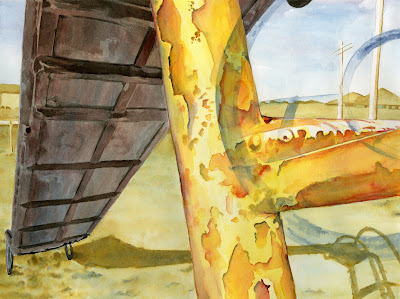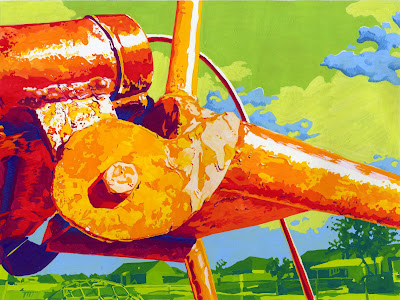 |
| Mid-Twentieth Century American Playground 6 Matthew D. Hughes Gouache on Bristol 9 1/2 x 12 1/2 inches 2011 |
I believe the reason I like this one so much is that it has an interesting composition. A close up of the rungs of a slide ladder, there is a great sense of depth on display. Although not deep space, the forced perspective gives the sense that you're actually looking down as you get ready to scale this ladder. Additionally, the progressive rhythm of the repetition of the rungs further enhances that illusion of depth.
Something else I just noticed while looking at this painting as I typed the above analysis is that the textile pattern on the rungs also further unifies the composition. Although it is not a pure, formal pattern due to the areas of corrosion and paint chippings, this is still a good example of a regular pattern that is repeated throughout the composition.
Upon first look, this painting appears to be a great example of a warm/cool color contrast. Reds and blues are typically used in that since. However, there is that small area of yellow. Even though yellow is a warm color, and could further be argued that this is about warm and cool, since it is used so sparingly it becomes more about the contrast of extension.
In the contrast of extension, a small amount of color is used to add an area of emphasis or create a focal point. Here, I used the yellow to further draw your eye down in the composition. The contrast of extension can also be applied by using objects. Consider a black and white photo of a small group of people talking close together while an unengaged man is standing off to the side. The lone person becomes an area of emphasis because he is not a part of the group. Although he is a person and thus a repetition of a "shape", since this guy is out of place be becomes the point of our focus because our minds wants him to be grouped with the other shapes that he is akin to. Our minds work the same way with color. In this painting, we expect the colors to all be reds and blues because these hues dominate the composition. However, since that yellow is so drastically different from the rest, it stands out.




